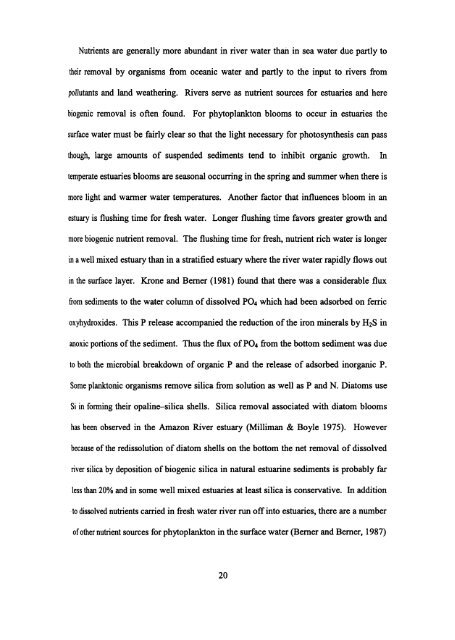Salinity Intrusion and Seasonal Water Quality Variations in the Tidal ...
Salinity Intrusion and Seasonal Water Quality Variations in the Tidal ...
Salinity Intrusion and Seasonal Water Quality Variations in the Tidal ...
Create successful ePaper yourself
Turn your PDF publications into a flip-book with our unique Google optimized e-Paper software.
Nutrients are generally more abundant <strong>in</strong> river water than <strong>in</strong> sea water due partly to<br />
<strong>the</strong>ir removal by organisms from oceanic water <strong>and</strong> partly to <strong>the</strong> <strong>in</strong>put to rivers from<br />
pollutants <strong>and</strong> l<strong>and</strong> wea<strong>the</strong>r<strong>in</strong>g. Rivers serve as nutrient sources for estuaries <strong>and</strong> here<br />
biogenic removal is often found. For phytoplankton blooms to occur <strong>in</strong> estuaries <strong>the</strong><br />
surface water must be fairly clear so that <strong>the</strong> light necessary for photosyn<strong>the</strong>sis can pass<br />
though, large amounts of suspended sediments tend to <strong>in</strong>hibit organic growth. In<br />
temperate estuaries blooms are seasonal occurr<strong>in</strong>g <strong>in</strong> <strong>the</strong> spr<strong>in</strong>g <strong>and</strong> summer when <strong>the</strong>re is<br />
more light <strong>and</strong> wanner water temperatures. Ano<strong>the</strong>r factor that <strong>in</strong>fluences bloom <strong>in</strong> an<br />
estuary is flush<strong>in</strong>g time for fresh water. Longer flush<strong>in</strong>g time favors greater growth <strong>and</strong><br />
more biogenic nutrient removal. The flush<strong>in</strong>g time for fresh, nutrient rich water is longer<br />
<strong>in</strong> a wellmixed estuary than <strong>in</strong> a stratified estuary where <strong>the</strong> river water rapidly flows out<br />
<strong>in</strong> <strong>the</strong> surface layer. Krone <strong>and</strong> Bemer (1981) found that <strong>the</strong>re was a considerable flux<br />
from sediments to <strong>the</strong> water column ofdissolved P04 which had been adsorbed on ferric<br />
oxyhydroxides. This P release accompanied <strong>the</strong> reduction of<strong>the</strong> iron m<strong>in</strong>erals by H2S <strong>in</strong><br />
anoxic portionsof<strong>the</strong> sediment. Thus <strong>the</strong> flux ofP04 from <strong>the</strong> bottom sediment was due<br />
to both <strong>the</strong> microbial breakdown of organic P <strong>and</strong> <strong>the</strong> release of adsorbed <strong>in</strong>organic P.<br />
Some planktonic organisms remove silica from solution as well as P <strong>and</strong> N. Diatoms use<br />
Si <strong>in</strong> form<strong>in</strong>g <strong>the</strong>ir opal<strong>in</strong>e-silica shells. Silica removal associated with diatom blooms<br />
has been observed <strong>in</strong> <strong>the</strong> Amazon River estuary (Milliman & Boyle 1975). However<br />
because of <strong>the</strong> redissolution of diatom shells on <strong>the</strong> bottom <strong>the</strong> net removal of dissolved<br />
river silica by deposition ofbiogenic silica <strong>in</strong> natural estuar<strong>in</strong>e sediments is probably far<br />
less than 20% <strong>and</strong> <strong>in</strong> some well mixed estuaries at least silica is conservative. In addition<br />
.to dissolved nutrientscarried <strong>in</strong> fresh water river run off<strong>in</strong>to estuaries, <strong>the</strong>re are a number<br />
ofo<strong>the</strong>r nutrient sources for phytoplankton <strong>in</strong> <strong>the</strong> surface water (Bemer <strong>and</strong> Bemer, 1987)<br />
20

















